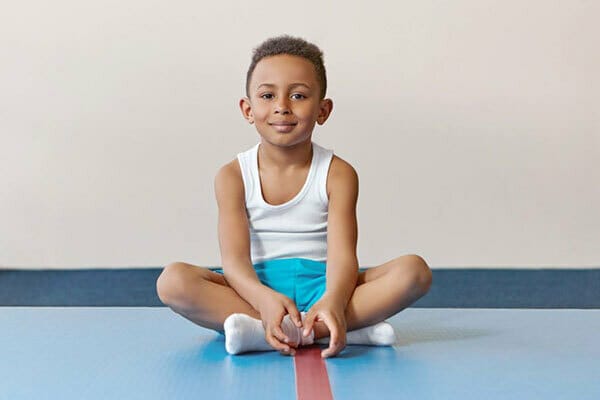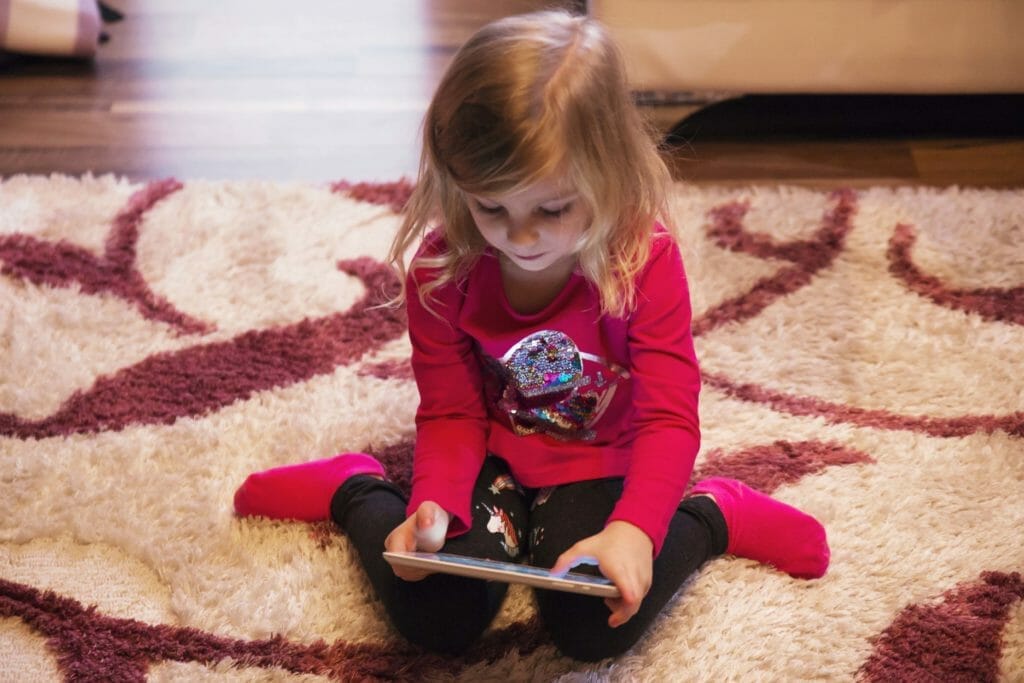Have you ever noticed the way your little one sits? If not, take a quick peek at your child! Looking from above, do their legs resemble the letter “W” when they sit? This is called W-sitting and it may or may not be your child’s body trying to communicate with you!
W-sitting has been a topic of many conversations and has led to controversial debates for years. If you google, “is W-sitting bad for my child?” you will get thousands of articles saying “yes,” “no,” or the ever so dreaded response, “it depends.” This article will save you from reading endless results and will guide you on how to respond when your child demonstrates W-sitting.
What is W-Sitting?
W-sitting is when your child’s knees, ankles, and bottom touch the ground with the feet positioned outside of the knees when seated. It earns its name from when you look at your child’s leg positioning from above and they resemble a “W”. Anatomically, this position places their hips into internal rotation, flexion and adduction. This means that the hips are resting in a position where they turn inward, bent forward, and held close to the body.
Is W-Sitting bad?
Yes and no, or I should say, “it depends.” Children often use W-sitting as a means to transition between different positions such as going from the ground to standing or from sitting to kneeling. Brief periods of time in W-sitting is not a bad thing. Whew! However, the issue arises when a child spends long periods of time in W-sitting or if it is a child’s ‘go to’ position. Yes, it may be a comfortable position for our very limber kiddos, but in the long run it alters and hinders proper gross motor development.
Why does my child W-sit?
As noted above, W-sitting can be a comfortable position and easily becomes a child’s preferred position. But more often, it is an indicator of an underlying issue. Children who W-sit often have weak core musculature. W-sitting gives them a wider base of support so that they do not have to rely on their postural muscles to maintain their balance while they engage in floor or table-top play. Secondly, some children who W-sit may have pre-existing hip anatomy abnormalities. Femoral anteversion is the inward rotation of the thigh bone in the hip. Children with femoral anteversion are prone to W-sitting as it is a position that they feel provides their hips more stability due to the inward rotation of the legs. Lastly, children who have decreased bilateral coordination skills will use W-sitting as an avoidance strategy to refrain from what they deem as a challenging task of reaching across their bodies. W-sitting provides increased trunk stability thus limiting rotation while participating in activities that incorporate crossing midline.
What are the long-term effects?
If left uncorrected, W-sitting can lead to a series of complications including:
Core weakness
When a child W-sits they are increasing their base of support making it easier to sit upright without activation of postural and core musculature. They rely less on these muscles to maintain this position and like we all know, if you don’t use it, you lose it!
Hip dislocation (Hip dysplasia) and alterations of supporting tissues
The hip joint is called a ball-and-socket joint where the femur (thigh bone) sits in the curvature of the acetabulum (pelvis). Typical anatomical alignment maintains the hip in slight internal rotation for stability between the two bones and allows for proper body mechanics for movement. However, W-sitting increases the amount of internal rotation of the hip and prolonged sitting in this position causes misalignment of the femur in the acetabulum and additional stress on the supporting ligaments. The excess stress on the ligaments supporting the hip can result in the stretching of these ligaments and possible tearing which can lead to dislocation of the femur or hip dysplasia.
Poor posture
W-sitting places the pelvis in posterior pelvic tilt and encourages slouched posture. Slouched postures decrease core muscle activation, increase difficulty with trunk extension and rotation in addition to increasing difficulty achieving and maintaining upright posture needed to complete age-appropriate activities.
In-toeing walking pattern also known as “Pigeon Toe”
Resting in a W-sit position places the hips in internal rotation, flexion, and adduction. Prolonged time in this position can contribute to abnormalities during walking. Internal rotation at the hips can cause inward positioning of the toes when a child ambulates. This gait pattern is called in-toeing or pigeon toe gait. This pattern can result in further issues such as knee and hip pain due to the abnormal distribution of weight and forces on the legs when in weight bearing positions.
Impaired bilateral coordination skills and fine motor skills
Bilateral coordination skills are introduced through play and participation in activities that require reaching across midline. Bilateral coordination skills are important for completion of activities that require both sides of the body to complete different movements simultaneously. For example, if a child tries to kick a ball one leg has to extend to stabilize and accept body weight, while the opposite side has to flex and swing in a kicking motion. Another example is one hand holding a piece of paper while the other uses a pair of scissors to cut shapes in the paper. W-sitting locks a child’s trunk in an upright position and decreases trunk rotation which is key to completing bilateral coordination activities. Without trunk rotation, children are limited in the directions that they can reach and move, thus hindering their development of coordination skills.
Additionally, when W-sitting, it is easier for children to reach for objects with both arms which delays the development of a dominant side. Hand dominance is an important skill of development that allows the participation in complex motor plans, motor accuracy and control, and dexterity. It is also important for the development of pre-writing, handwriting, and fine motor skills. However, with W-sitting, children become accustomed to using both hands instead of learning to rely on one hand to complete fine motor activities and crossing midline activities.
How do we address W-sitting?

- Cross-legged: Better known as Criss Cross AppleSauce, it is a common sitting position where a child sits with their feet crossed and knees apart.
- Side-sit: when a child shifts their weight onto one hip, stacks both legs on one side of their body and bends their knees
- Long-sit: When a child sits on their bottom with both legs straight in front of them
- Short kneeling: A child kneels and sits back on their feet maintaining their bottom on their heels. This position helps challenge a child’s balance with the narrow base of support while encouraging them to utilize their core musculature.
- High kneeling:A child is kneeling and maintains their bottom off of their feet. This position is a great way to activate the glutes and core muscles.
- Squat positioning is a great choice for overall strengthening of the major muscle groups
- Half kneeling: A child positions him/herself with one knee on the ground and the opposite foot flat on the ground with their knee bent. This position is great for strengthening muscles as well as stretching tighter muscles.
- Prone lying: No one is too old for tummy time! This position allows for development of head and trunk control while simultaneously developing the visual system.
Resources:
- Leblebici, G., Akalan, E., Apti, A., Kuchimov, S., Kurt, A., Onerge, K., Miller, F. (2019). Increased femoral anteversion-related biomechanical abnormalities: Lower extremity function, falling frequencies, and fatigue. Gait & Posture, 70, 336-340. doi:10.1016/j.gaitpost.2019.03.027
- Sielatycki, J. A., Hennrikus, W. L., Swenson, R. D., Fanelli, M. G., Reighard, C. J., & Hamp, J. A. (2016). In-Toeing is often a primary Care orthopedic condition. The Journal of Pediatrics, 177, 297-301. doi:10.1016/j.jpeds.2016.06.022
- What is W-Sitting & how to Prevent it?: Child development. (2020, November 09). Retrieved May 11, 2021, from https://pathways.org/what-is-w-sitting/
- What is bilateral coordination and why is it important?: Child’s okay therapy center. (2014, August 06). Retrieved May 12, 2021, from https://www.childsplaytherapycenter.com/bilateral-coordination-important/

